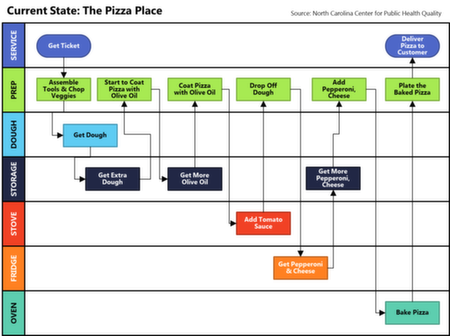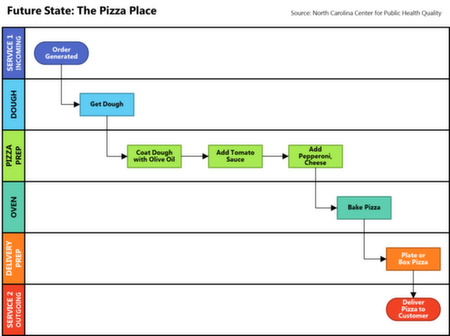Tools and Training
Swim Lane Map
Also called: Process flow diagram
On this page:
What is a swim lane map?
How to build a swim lane map
More information
Sources
What is a swim lane map?
A swim lane map is similar to a flowchart in that it maps out a process, decisions, and loops; however, a swim lane map places events and actions in "lanes" to delineate a person/group responsible, or a specific subprocess.
A swim lane map has three elements: time, people (or job functions), and tasks/processes.
How to build a swim lane map
Place your people, departments, or job functions in one column, and draw lanes next to each area. For example:
| Customer | |
| Customer service | |
| Sales | |
| Order entry | |
| Accounting | |
| Shipping |
Source: Minnesota Enterprise Lean
1. Walk the process
Start from the beginning, and document the process to the end. Questions to ask:
- Where does this information come from?
- Is the process completed with or without interruption?
- Do you ever miss information or have incorrect information
- Where does the information go from here?
- Is there more than one place the information goes?
- Is there new information or is it being translated into another form?
2. Characterize the process
- What forms, screens, or programs does each step use?
- How long does each step take?
- Are there handoffs, where the task travels from one person to another? How does it happen?
- Is there consistently missing information, duplication, multiple locations for the same data, etc.?
- Where do you wait for someone to make a decision, or for information to be placed in (for example) an inbox?
- Does inspection/approval happen at any point(s) during the process?
- Are there points where you need to enter data for the sole purpose of making the business system work (AKA system requirements)?
3. Map the process (current state)
Identify every step of the process, and sequence tasks in a linear fashion across the map, placing them in the "lane" where they occur in roughly the order they occur. Use the following colors/Post-Its™ to indicate events and actions:






Your swim lane map could be quite long, as some processes include a large number of tasks/steps. See, for example, this swim lane map from a 2012 Kaizen event, which ran the length of a room. Many swim lane maps are even longer than this.

Although the following swim lane map doesn't adhere to the style outlined previously, using different colors for tasks, action steps, delays, etc., it still illustrate the benefits of mapping a current process, and developing improvements for a future state.
4. Prepare your roadmap (future state)
After sequencing your tasks, characterize and label them as adding value, or as not adding value. Work to eliminate non-value added steps, and connect the value-added steps together without waiting or handoffs. Barriers to the "perfect" transaction include:
- Poor information: Missing information, inaccurate information, assumptions, system requirements
- Poor information flow: Handoffs, waiting, organizational structure, information/knowledge siloes
Eliminate missing information:
- Require all information from the customer before the job launches
- Add hard stops that don't allow partial data entry
Eliminate inaccurate information:
- Use menus where a small number of choices exist
- Create a review process with the customer before the job launches
- Create and report on measurements for information accuracy
Eliminate handoffs:
- Identify the value-added tasks and their owners
- Relentlessly challenge the idea that one person cannot perform more than one step in sequence
- Identify what needs to be done to achieve a zero-handoff stream (e.g., in training, structure, IT)
Eliminate waiting:
- Eliminate handoffs
- Make every effort to ensure clear, accurate information is gathered upstream
More information
How to Create a Swimlanes Flowchart (3:06)
YouTube: sixsigmamoneybelt
Swimlane or Functional Process Maps (4:01)
YouTube: phill chambers
Swim Lane Diagrams
MindTools
Sources
Minnesota Office of Continuous Improvement
Center for Public Health Quality, North Carolina

